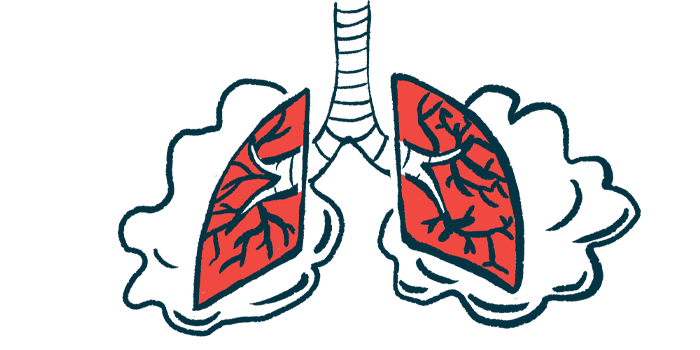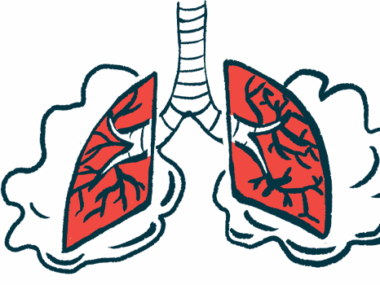Combination therapy may safely stabilize AAV-related lung disease
Proof-of-concept study supports use of rituximab plus glucocorticoids
Written by |

A combination of rituximab (sold as Rituxan and biosimilars) and low-dose glucocorticoids may safely stabilize interstitial lung disease (ILD) related to ANCA-associated vasculitis (AAV), according to a small proof-of-concept study by researchers in Italy.
After a year of this therapeutic regimen, the study’s participants saw a significant reduction in AAV disease activity and the stabilization of several measures of lung function, data showed.
Rituximab and glucocorticoids are common treatments for AAV, but not for ILD. Their potential efficacy in these cases suggests that treating the underlying AAV — autoimmune diseases characterized by inflammation and damage to small blood vessels — may help stabilize secondary conditions such as ILD.
In a highlights section atop the study, the researchers wrote: “Rituximab is effective in stabilizing imaging and functional features in AAV” and “a short course of steroids does not impair the effectiveness of the scheme.”
The study, “Efficacy and safety of rituximab and low dosage of glucocorticoids for ANCA associated vasculitis interstitial lung disease: a proof-of-concept study,” was published in the journal Respiratory Medicine.
AAV is a group of disorders in which the immune system mistakenly attacks small blood vessels throughout the body, causing inflammation and damage. Self-reactive antibodies called ANCAs are typically at the root of this immune response. Symptoms vary broadly depending on the impacted tissues, but many patients experience kidney or lung problems.
One such lung issue is ILD, or inflammation and scarring (fibrosis) between air sacs in the lungs. This makes it more difficult for the lungs to exchange carbon dioxide and oxygen. Estimates of ILD prevalence in AAV vary from 13% to 45%, but clinicians currently don’t consider it a typical feature of AAV, according to the researchers.
The team noted that clinical guidelines “refrain from providing clear-cut recommendations,” meaning the management of this issue “relies on the clinician’s choice.” While some clinicians prefer to use standard AAV treatments, others opt for antifibrotic medications and other ILD treatments.
8 patients in small study given combination therapy for 1 year
In this study, researchers from the University of Siena investigated the use of rituximab and glucocorticoids — often used for other manifestations of AAV — in people with AAV with ILD. Together, this therapy combination suppresses the immune system and its inflammatory attacks.
The small trial involved eight participants with the two most common forms of AAV: five with microscopic polyangiitis (MPA) and three with granulomatosis with polyangiitis (GPA). All tested positive for ANCAs and had diagnoses of ILD. At the time of diagnosis, their mean age was 68.
“Most of the enrolled patients were referred to our center for a second opinion and had already been treated with other immunosuppressants,” the team noted.
At the start of the study, the participants received two 1,000 mg intravenous, or into-the-vein, infusions of rituximab, separated by two weeks. After that, all received a maintenance dose of 500 mg every six months for a year. The patients took oral prednisone, a type of glucocorticoid, with a reduced-dose tapering plan that had previously demonstrated efficacy for kidney manifestations of AAV.
By the end of the year, 75% of participants were no longer taking prednisone, while the remainder were on a low dose, the researchers noted.
Stabilization or lessening of abnormalities seen on CT scans
After six months of treatment, the participants showed an improvement in disease control. Specifically, the average Birmingham Vasculitis Activity Score (BVAS) fell from 7 to 1, reflecting a significant reduction in AAV disease activity. The BVAS then stayed consistent after one year of assessment, per the researchers.
Several metrics of lung function remained stable or changed in very small ways, the data also showed. Diffusion capacity of the lungs for carbon monoxide (DLCO), a measure of how efficiently the lungs exchange oxygen and carbon dioxide, gradually increased from 49.75% to 57.5%, resulting in a statistically significant increase during treatment. Higher DLCO indicates higher gas exchange capacity.
Likewise, participants saw stabilization or lessening of imaging abnormalities on high-resolution CT scans of their lungs. Five saw no change, while the remaining three saw partial resolution of some abnormalities.
“Our findings have displayed that [rituximab], prescribed in association with a short course of [glucocorticoids], is able to stabilize imaging features and respiratory functional parameters,” the researchers wrote.
There were no serious adverse events directly related to the combination therapy. The team hypothesized that this could be associated with the low dose and early withdrawal of glucocorticoids. Because these medications heavily suppress the immune system, they may have severe side effects. A shorter treatment course could reduce the risk of developing infections or other adverse events, the team noted.
Based on these results with a standard AAV treatment for AAV-associated ILD, the researchers suggested that the disease-causing processes of ILD in this situation are related to underlying AAV. However, “due to the lack of [a] control group, we are not allowed to state the efficacy of [rituximab] over other immunosuppressants,” the team wrote.
Future studies could investigate this treatment regimen in larger groups, according to the researchers, who noted that their findings “should be confirmed by a larger, multicentric, trial.”







